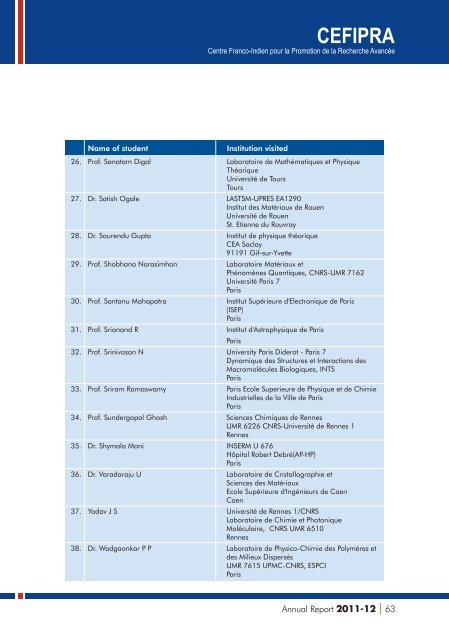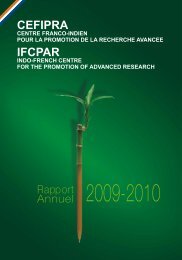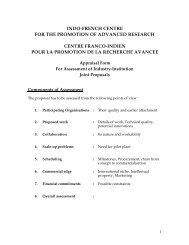IFCPAR AR (ENGLISH) for CD - CEFIPRA
IFCPAR AR (ENGLISH) for CD - CEFIPRA
IFCPAR AR (ENGLISH) for CD - CEFIPRA
You also want an ePaper? Increase the reach of your titles
YUMPU automatically turns print PDFs into web optimized ePapers that Google loves.
<strong>CEFIPRA</strong><br />
Centre Franco-Indien pour la Promotion de la Recherche Avancée<br />
Duration: Three years (February, 2011 to January, 2014)<br />
Objectives<br />
While carbon substitution into a borane cage is common and<br />
gives rise to an entire class of compounds (carboranes), silicon<br />
substitution is rather rare. There are only few examples of<br />
silaboranes which are directly related to carboranes by<br />
substitution of silicon <strong>for</strong> carbon. The most convenient method <strong>for</strong><br />
the preparation of metallacarboranes is based on a reaction<br />
between metallaboranes/boranes and alkynes. The new<br />
millennium has witnessed the synthesis of the first stable examples<br />
of homonuclear alkyne analogues of the heavier main group 14<br />
elements, which in turn, makes it important to extend the scope of<br />
this reaction. Main-group-element unsaturated organic<br />
substrates, will be designed and their reactivity established with<br />
group 5-9 metallaborane complexes.<br />
Furthermore, a comprehensive synthetic and per<strong>for</strong>mance<br />
evaluation study of the compounds, if confirmed by XRD, will be<br />
carried out with the aim of gaining insight about the geometryfunction<br />
correlation of these complexes. Apart from the<br />
a<strong>for</strong>ementioned reactivity studies, a detailed structural study of<br />
the complexes will be carried out to understand the structureproperty<br />
relationship.<br />
Intimately linked to these experimental studies will be parallel<br />
c o m p u t a t i o n a l w o r k . T h e o r e t i c a l s t u d i e s o n<br />
metallaheteroboranes using quantum chemical calculations will<br />
reveal critical in<strong>for</strong>mation on their <strong>for</strong>mation, structures and<br />
stabilities. Wherever possible computed structures and physical<br />
properties (e.g. NMR shifts) will be correlated with their<br />
measurable experimental equivalents. Computations will serve<br />
as both rationalising and guiding the experimental work, with the<br />
ultimate overall objective of establishing a firm understanding of<br />
the systems synthesised.<br />
Accomplishments<br />
i) Interpretation of the molecular structure and electrochemical<br />
properties of the metallaborane complex Cp*Ru(B H )RuCp*<br />
8 14<br />
(Cp* = 5-C5Me5) has begun. This compound is unexpectedly<br />
apparented to pentalene complexes such as<br />
Cp*Fe(C H )FeCp* (C H = pentalene) which possesses the<br />
8 6 8 6<br />
same valence electron count<br />
η<br />
C5Me5Mo) 2 B5H 6( μ3-OEt) and ( η -C5Me5Mo) 2 B5H 5( μ3-OEt)(n-<br />
OBu) where oxygen is contiguously bound to both cluster<br />
metals and boron atoms is currently theoretically studied, in<br />
order to rationalise their electron count, their bonding, the<br />
number of hydrogen atoms, and their NMR properties<br />
ii) The electronic structure of the oxamolybdaborane clusters (<br />
5<br />
5<br />
-<br />
Research papers published: Nil<br />
Project 4405-1<br />
CHEMISTRY AND APPLICATION OF METALLASILA- AND<br />
METALLAGERMABORANES DERIVED FROM GROUP 14<br />
UNSATURATED ORGANIC SUBSTRATES<br />
Research Activities 2010-11<br />
Pure & Applied Chemistry<br />
Prof. Sundargopal Ghosh<br />
Department of Chemistry<br />
Indian Institute of Technology Madras<br />
Chennai<br />
Prof. Jean-François Halet<br />
Sciences Chimiques de Rennes<br />
UMR 6226 CNRS-Université de<br />
Rennes 1<br />
Rennes<br />
63





